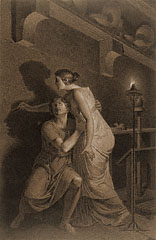• Describe what is happening in this scene. How does the artist's use of light and shadow affect the mood of the drawing?
(A young woman traces the shadow of her lover on a wall. The lover holds her waist and looks over his shoulder to see her work.
The artist uses light and shadow to create an intimate and romantic setting. He also uses light to draw attention to the expressions
and actions of the characters.)
• What is the setting for the scene? What visual evidence leads you to this conclusion? (The scene is set in ancient Greece in
the interior of a potter's workshop. The clothing of the figures, architectural elements, shapes of the pots and oil lamp, and the
workbench lead to this conclusion.)
• The artist drew this image on brown paper using black and white chalk. How would the image be different if he had used white
paper instead? (The images would be stark and would lack the warm mid-tones that are made by the use of brown paper.)
• The subject of this work of art is the Invention of Drawing. This was a popular subject for artists during the Enlightenment because it embodied values of that time period. How would you describe those values based on what you see in this
work of art? (Loyalty, duty valued over relationships, inventiveness.)
• The Roman author
Pliny the Elder was the first to record this story, which gives a noble and poetic origin to the art of
drawing. According to this visual depiction of that myth, what are the roots of drawing and why might they be considered noble?
(The roots of drawing come from
antiquity, and the art was born of the desire to remember a loved one.) |
This drawing replicates a painting that the artist exhibited in the Paris
Salon of 1791. It depicts Dibutade, the daughter of an ancient potter, tracing her lover's profile on a wall of her father's studio in order to retain
a remembrance of her beloved's appearance after his departure. This story, The Invention of Drawing, is taken from Pliny the
Elder's Natural History and was a popular subject for 18th-century artists. Joseph- Benoît Suvée rendered this
legend in his typically polished drawing technique. Dramatic
chiaroscuro lighting enhances the theatricality of the scene. The light from a single flame of an oil
lamp throws large shadows of the lovers' heads onto the wall behind them and creates dark areas under arms and chins, all of which
serves to focus attention on the half-lit faces. Dibutade's skin and the fabric of her clothing shimmer under the same light,
rendered by the artist with variegated whites. These carefully observed and skillfully rendered nuances give Suvée's drawing
a lively and passionate quality. His rendering of the costumes and furnishings of an ancient pottery studio demonstrates the
Neoclassical interest in archeology.
About the Artist
Joseph-Benoît Suvée, 1743–1807
Belgian
At age eight, Joseph-Benoît Suvée began studying at the Royal Academy of Bruges. After winning multiple first prizes,
he left for Paris in 1763 and enrolled at the
Académie Royale the following year. He won the
Prix de Rome in 1771,
triumphing over Jacques-Louis David, who complained that Suvée used personal connections, a charge that may have been true.
In Rome from 1772 to 1778, Suvée made chalk drawings of the countryside, combining a taste for picturesque ruins with
archaeological accuracy and monumental style. His work included official state commissions, tapestry cartoons for the Gobelins
Tapestry Manufactory, religious paintings, and psychologically penetrating portraits. He often painted emotional scenes, which
he treated with Neoclassical restraint, creating simple compositions, crisp and precise draperies, and idealized figures.
In 1801 Suvée became director of the Académie de France at Rome, which became his best-known legacy; the responsibilities
of running the school caused him to abandon painting completely.
|
